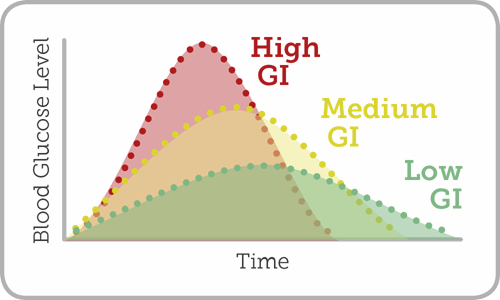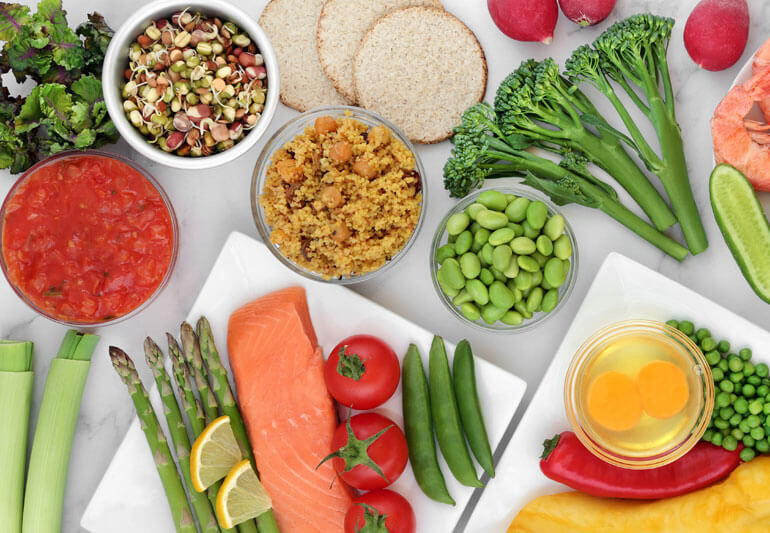Glycemic Index Calculator is a calculator used to determine the glycemic index for the most common type of foods. Besides displaying the GI score values, our calculator will also tell you whether the particular food belongs to the low (healthy) or high (critical) range.
In the following text we will present you what is glycemic index, its history, some interesting facts and at the end show you how to use our calculator with practical example. In addition, check out this category if you need more health-related calculators, or you can directly see our Smoking Pack Year, Qtc or Total Body Water calculator.
Take a look other related calculators, such as:
- Mentzer index calculator
- Glycemic load calculator
- Micronutrient calculator
- Venous blood gas interpretation calculator
Glycemic Index – What is Glycemic Index?
Glycemic index (GI) shows how much carbohydrate enters an individual’s blood and raises their blood sugar & insulin levels after eating a certain type of food (affecting their health and increasing weight). Therefore, each food has a different glycemic index. GI score can be between 0 and 100 values. For example, if a particular food has a GI score of 100, it indicates that the food consists of only glucose (pure sugar). Not only does a glycemic index score help you raise awareness about how much glucose you eat per lunch, but it also plays an important role in reducing cholesterol and fastening weight loss, and helping people with diabetes.

History
A long time ago, in 1981, when it was introduced, people used the glycemic index only to help patients with health issues such as diabetes. However, today if we consider its use, we can see that people use the GI score not only for diabetes but also for weight loss diets and other nutrition aspects.
GI predicts the way certain foods affect your blood sugar levels
We already mentioned that there is no one universal GI score for every type of food, but they all have different glycemic indexes. Thus, the higher the GI score we get, the more it raises an individual’s blood sugar and insulin level (the more it afflicts health).

For example, some general approaches we take are the glycemic index score values below:
- Low GI: 55 or less
- Medium GI: 56–69
- High GI: 70 or above
However, in order to know how high or low the GI score will be, we can mention the most common factors under the glycemic index depends:
- Carbohydrate quantity and type found in the food (For example, short-grain white rice has a higher glycemic index than brown rice or long-grain white rice),
- The carbohydrate entrapment of molecules in the meal,
- How much protein and fat do we find in the food?,
- The number of organic acids in the food,
- The meal’s thermal treatment (Foods that we cook for a longer time have a high glycemic index – worse for health).
Low Glycemic Index and High Glycemic Index
How do we know what foods have lower and higher glycemic index values?
This question we can break down into two parts and explain it through a simple rule:
- If carbohydrate in food transforms and breaks down into glucose in a very short time, that food will have a higher GI score.
- On the other hand, if we eat food that contains a lot of protein and fat, we will get a lower GI score.
- Special case: if food quickly turns into glucose, but it contains a lot of fiber, the GI score will not be high but low. The reason why is because fiber slows digestion and the release of glucose (good for diabetes).
The standard rule tells that:
- A low glycemic index is considered a value of 55 or less.
- A high glycemic index is any food with a value of 70 or more.
Glycemic Index vs. Glycemic Load
A Glycemic index cannot tell you all the information you need when tracking and monitoring one’s blood sugar and insulin level. When an individual has a meal, the glycemic index score will calculate how quickly glucose (sugar) enters the individual’s blood. Therefore, it doesn’t tell you how much glucose it can deliver per meal. To manage and control that aspect, we also need to measure the glycemic load of the individual. That is why these two medial terms are close and used in conjunction.
For example, a banana has a GI score of 51, but its glycemic load score is four or five times lower, between 11 and 13.
What is the Glycemic Index Diet?

A Glycemic index diet is a special set of instructions designed to include only foods of low glycemic index score in the meals. As a consequence, you will eat healthier food, and the amount of glucose in your blood will decrease (diabetes solution). In other words, you will lose weight.
Importantly, the glycemic index diet does not specify the exact size of the portion you need to follow strictly compared to other popular diets. In particular, we can claim that all the modern popular diets that you can see in the magazines are essentially based on the glycemic index, such as Sugar Busters or the Slow-Carb Diet.
The Glycemic Index and Carbohydrate
The top four sources of a body’s energy are carbohydrates, fat, protein and alcohol. However, carbohydrates are undoubtedly the primary and most popular source of energy. Each food contains a certain percentage of it. Thus we cannot get rid of carbohydrates. Generally, we measure how carbohydrates quickly turn into glucose and stay in the individual’s blood. Therefore, this indicator tells us what food to choose and avoid in the meal plans.
Glycemic Index Chart
Here is the chart representing some common foods and their respective glycemic index.
| Foods | Glycemic index (GI) |
| Apples (120g) | 40 |
| Bananas (120g) | 47 |
| Grapes (120g) | 43 |
| Oranges, raw (120g) | 48 |
| Strawberries (120g) | 40 |
| Potato, white, boiled (150g) | 54 |
| White rice, boiled (150g) | 47 |
| Sushi (100g) | 55 |
| Watermelon (120g) | 80 |
| Rutabaga (15g) | 72 |
| Potato, instant, mashed, (150g) | 88 |
| Total cereal (250g) | 76 |
| Waffles (35g) | 76 |
| White bread (30g) | 70 |
| French fries (150g) | 75 |
| Pizza, cheese (100g) | 80 |
Glycemic Index Calculator – How to Calculate?
We have a table of types of foods and their GI score values, but have you ever asked yourself how the calculation works?
Steps:
- First, you pick ten volunteers for the research and give them 50 grams of digestible carbohydrates. Then, you need to measure how carbohydrates affect their blood glucose and levels for the next 2 hours.
- Secondly, we should observe the AUC glucose graph. Divide the AUC glucose test of each volunteer by the AUC graph values of the volunteer for the referenced food.
- Thus, repeat the steps for each participant, and you will find the average AUC glucose index.
Glycemic Index Calculator – Example
You were shown the steps on manually calculating a person’s GI score in the previous section. However, we highly recommend you to use our Glycemic Index Calculator instead. Because of its easy-to-use approach and quickness, you will instantly get the GI score of the food you select. Foods are grouped into six categories, and you can simultaneously check the GI score for multiple types of foods.
Scenario: For example, you want to see the GI score for strawberry yogurt and french fries.
- Head over to the “Dairy and alternatives” category and select “Yogurt, strawberry”
- The calculator instantly calculates the glycemic index and display it under the category
Glycemic index: 30
🟢 Low GI
- Then, let’s check the GI score for “Potato, french fries”
Glycemic index: 64
🟠 Mid-range GI
FAQ
What is a glycemic index?
The Glycemic index indicates how much carbohydrate enters an individual’s blood and raises its blood sugar and insulin level after eating a certain type of food. GI score values give us an idea of what food is good for health or what food you should avoid if you have diabetes or weight issues. The GI score can be between 0 and 100, depending on the type of food you eat.
How to calculate glycemic index?
You can easily calculate the glycemic index using our Glycemic Index Calculator. First, select the category of food and the items you want. As a result, our calculator will display the GI score and report whether the food item has a low mid-range or high GI score.
What is the glycemic index of fruits?
It depends on which fruit you are checking the glycemic index for. For instance, cherry has a GI score of 22, whereas watermelon has a very high GI score of 76.
What is the glycemic index for mango and wild rice?
The GI score for wild rice is 57 (mid-range). In contrast, the glycemic index for mango is 51 (low-range).
What is a good glycemic index?
Healthy food (good GI score) is considered any food that belongs to the low-range, 55 and less.
What foods have a high glycemic index?
Here is a list of foods with a high GI score (the food you need to avoid, for example, if you have diabetes issues):
– white bread
– white rice
– cakes and cookies
– potatoes and fries
– chips
– watermelon and pineapple
– fruit yogurts
